Interview with Andrii Kobzar - an experienced gunner and commander of the Panzerhaubitze 2000 calculation.
Publication date: 4 days. ago
Reading time: 12 minutes to read
The story of the hero of today's interview Andriy Kobzar has been a member of the UNSO since the 1990s, served in 1997-1998. in the 820th MSP of the 128th MSD (now - 128 OGSHBr) - on the 2S1 self-propelled guns.
In September 2014, the 44th separate artillery brigade was formed, and Andriy was working on the 2A65 "Msta-B" howitzer at that time. Battles were fought according to n.p. Shchastia, Crimea, the battles were on the Bakhmutivskaya highway, the Horlivskyi direction... In September 2015, he was demobilized.
On the first day of the full-scale invasion, together with his brother, they gathered a group of artillerymen in the morning and insisted on sending them to the nearest artillery station immediately. Such a unit was the 43rd OABr. The calculation
(I presume in this context it means Fire Direction Officer (FDO)) worked with the 2S7 Pion self-propelled guns. Battles near Brovary, then near Berezany, then - Izyum, Lyman and Bakhmut directions. In mid-July 2022, part of the unit was sent to Germany to learn Panzerhaubitze 2000 at the artillery school in Idar-Oberstein. (Die Artillerieschule in Idar-Oberstein) - the central training center for artillerymen of the Bundeswehr.
Thus, Andriy Kobzar became Geschutzenfuhrer - gun commander. The training lasted a month and a half in total. As early as November 2023, calculations on German howitzers went to Bakhmut.
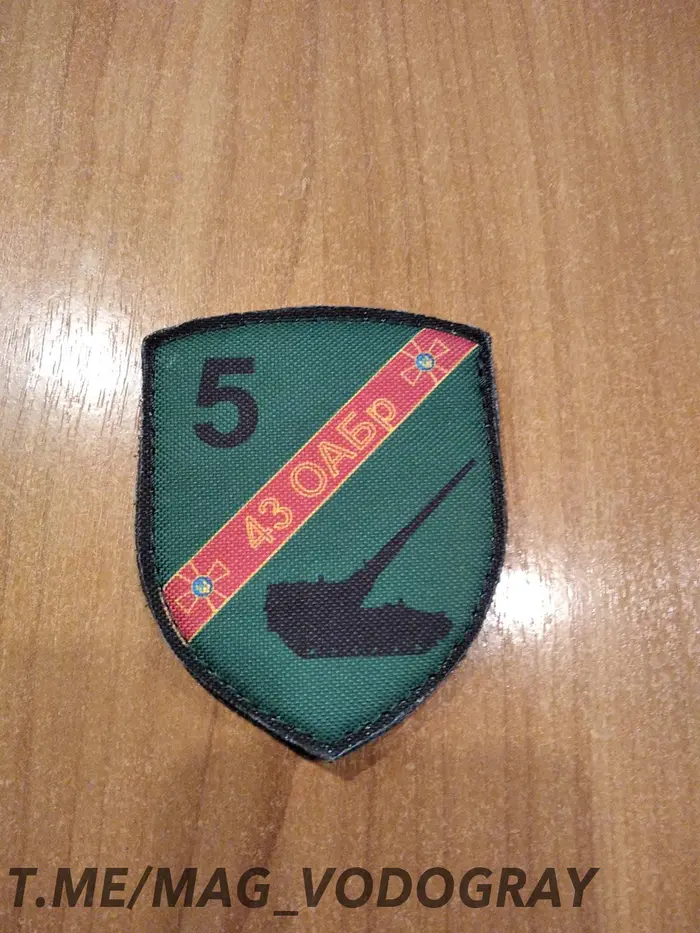 Chevron of one of the artillery batteries of the 43rd OABr with the image of a PzH-2000
Chevron of one of the artillery batteries of the 43rd OABr with the image of a PzH-2000
Then - Svativsky direction, then work near Siversk, then again Svativsky direction, then Soledar. On May 16, 2023, Andriy was seriously injured and concussed. Unfortunately, the driver mechanic, who was one and a half meters away from Andriy, died, the cause of death was a KOBE 3B30 cumulative submunition hit. The rest of the crew and the howitzer were not injured.
Discussion on the topic...
PzH-2000 is a tracked self-propelled gun. Tracked chassis - to a greater extent an advantage, a disadvantage or a necessity in the conditions of Ukraine?
Both wheeled and tracked chassis have their advantages and disadvantages. But, during operation, an unobvious advantage of the tracked chassis was revealed - it allows you to reserve the self-propelled guns, reliably reserve them. An example of this is the PzH-2000.
The wheeled chassis is not capable of carrying such a load. Caesar is an excellent artillery installation. But the war changed, FPV drones, Lancets appeared. Now its advantage in lightness and maneuverability is not so significant, but the threat to the crew working from outside the machine is very great. When it "flys" into the car, it flies in all directions, people die. And that's it, you waste the crew. You can't install a closed combat compartment with a tower there.
The wheeled chassis obviously also has its advantages, but not without such nuances.
There are, of course, self-propelled guns such as Dana, Dita, Zuzana, which have a tower, and the protection of the crew is better there. From kamikaze UAVs, such reservation will not help much, but from their classic counter-battery link - Orlan UAVs and BM-27 Uragan rocket launchers with cluster rockets, it helps.
Like, there is a Ukrainian self-propelled gun, working on orcs. They (the orcs) see it from Orlan and start sowing everything with "cassettes". And when SPG crew works from the outside, the consequences can be fatal. This is how the crew of a 2S7 Pion died in our country. Only the commander and the driver-mechanic survived, being injured. Because they were in the installation, not near it. But we all work in the car, behind the armor.
So I think both types of chassis have the right to life, but the tracked chassis allows for much better protection of the crew.
Regarding booking: what kind of hits can it take? What methods of protection against UAVs exist and how effective are they?
It all depends on the angle at which something hit the self-propelled gun and whether additional passive armor was installed at the point of impact.
As an example, recently we were not pierced with a lancet.
What is this armor block made of? This is a textolite block on a steel base. It is interesting that there is also a gap between the armor of the self-propelled guns and this additional reservation.
In addition to booking the SPG directly, strong trees can also help from the Lancets, if you stand somewhere under them. And if you stand in a "hut" made of chain-link netting, it's even better.
Not in our unit, but in another, in PzH-2000, 5 Lancets were launched one after the other. At first they pierced this chain-link net. As a result, they still managed to damage the self-propelled guns, but they did not destroy them uncritically. Without detonation and other things, although it was the most damaged self-propelled gun. It was then taken for repairs.
Therefore, to protect against UAVs, you need to look for trees with thick trunks, make a high-quality "hut", and the armor on the PzH, which is better than on any self-propelled guns, becomes an additional pleasant bonus.
 A trace of a fragment of a 152-mm projectile that broke on a branch above the self-propelled gun. The PzH-2000 survived the hit, whether the conditional M109 or AHS Krab would have survived such a fragment is already a question.
A trace of a fragment of a 152-mm projectile that broke on a branch above the self-propelled gun. The PzH-2000 survived the hit, whether the conditional M109 or AHS Krab would have survived such a fragment is already a question.
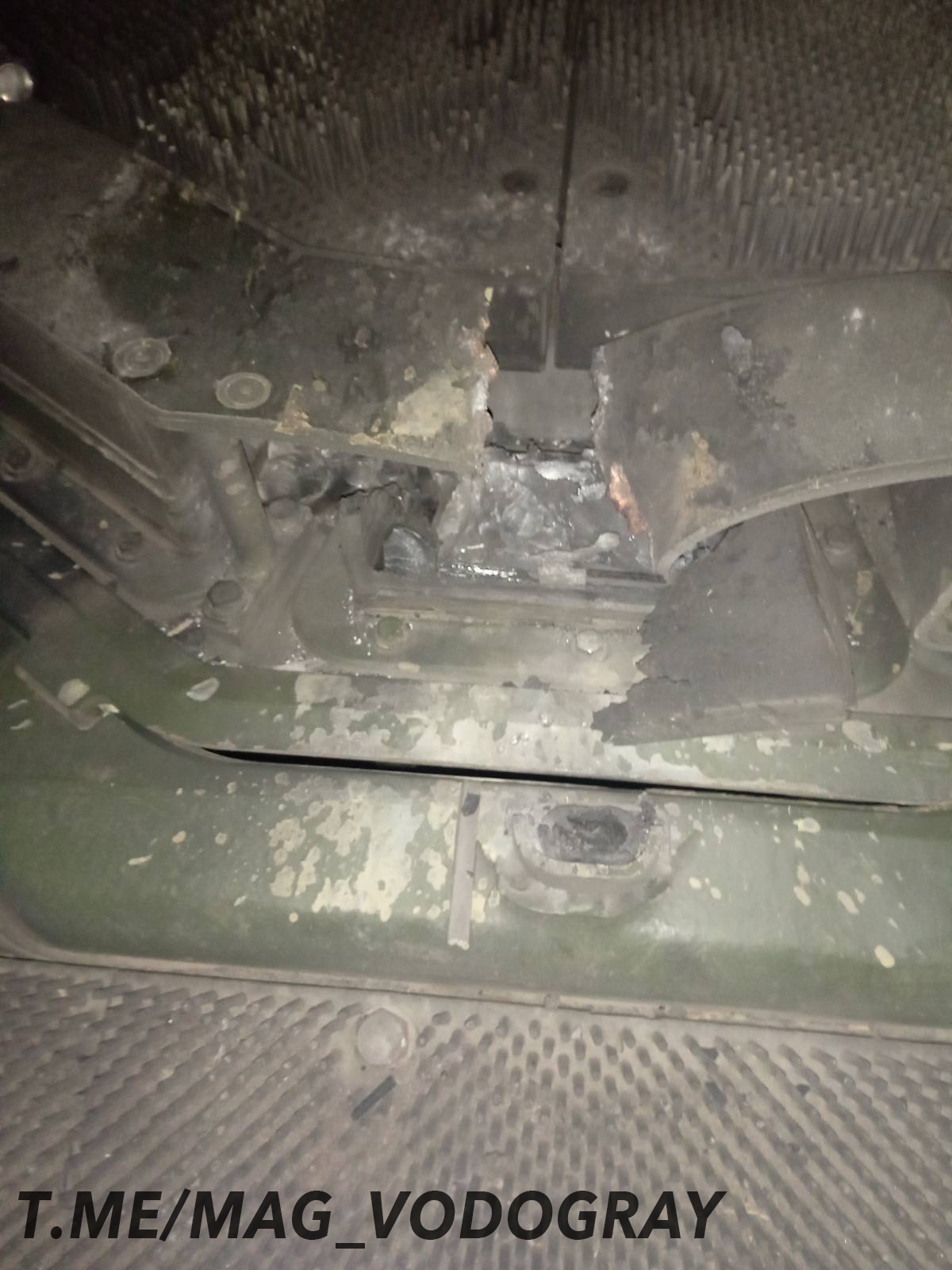 "This is the last one. Our crew was running away from the lancets. He maneuvered from two - the speed is skillful, as they say in his training... and one still flew, rammed the driver mechanic hatch, the hatch was bolted in combat mode. As you can see, the additional anti-cumulative armor absorbed the blow, then demolished the edge above the triplex, demolished the triplex, nevertheless the armor was not penetrated. The armor is very good."
How do you rate the effectiveness and feasibility of using SMART and Bonus projectiles? All in all, I'm interested in your thoughts on rounds with smart submunitions for anti-tech.
"This is the last one. Our crew was running away from the lancets. He maneuvered from two - the speed is skillful, as they say in his training... and one still flew, rammed the driver mechanic hatch, the hatch was bolted in combat mode. As you can see, the additional anti-cumulative armor absorbed the blow, then demolished the edge above the triplex, demolished the triplex, nevertheless the armor was not penetrated. The armor is very good."
How do you rate the effectiveness and feasibility of using SMART and Bonus projectiles? All in all, I'm interested in your thoughts on rounds with smart submunitions for anti-tech.
Yes, indeed, we worked SMART. And it was my self-propelled gun that was chosen to use these shells.
We received them in sufficient quantity at the end of February 2023. We worked with them, figured out how to use them.
The weapon is very effective, nothing saves from it. Sensors installed in sub-munitions clearly identify and find enemy targets.
Our task is to get the projectile to the target and correctly program the blaster so that it opens the projectile correctly, approximately at the rear point.
After deployment, the submunitions fly out and begin to descend on their parachutes. Parachutes are attached not symmetrically, as if in a spiral.
In a radius of 200 meters, submunition detectors are activated: infrared, proximity. In short, let's not tell too much. They clearly and reliably identify targets, whether it is a mock-up or a fake. This is enough to know.
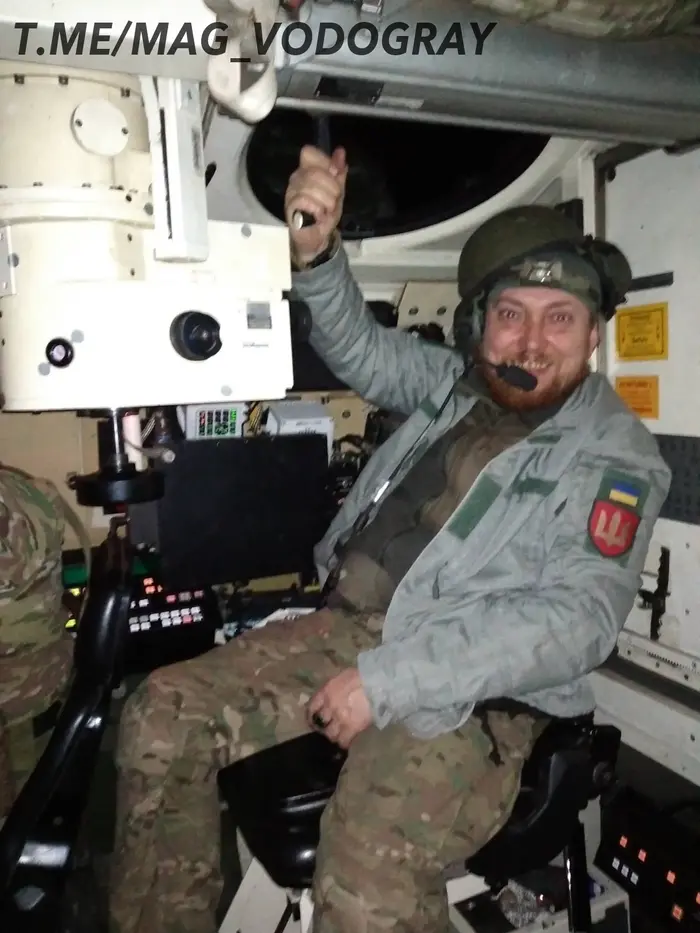
After that, the submunitions descend on the found targets, detonate and hit them with a special warhead made of niobium. The submunition is detonated at a height of 20 meters above the surface. This impact core is capable of hitting any existing enemy equipment in the upper hemisphere. Even "barbecue" will not become an obstacle for him.
Another advantage of this type of submunition projectile is that it cannot be jammed like GPS guided projectiles like the M982 Excalibur or Vulcan. Here, everything is brought to life and everyone is killed.
We spent about 30 shells to clearly understand how these shells work. In total, we used about 140 of them, 136 to be exact. Until they ran out. 36 for firing, that's 100 shells that we used in a month and a half of active use. During this period, under video recording, they hit 41 tanks and a certain amount of other equipment: BMP, trucks and towed guns.
By the way, beautiful thing, works great.
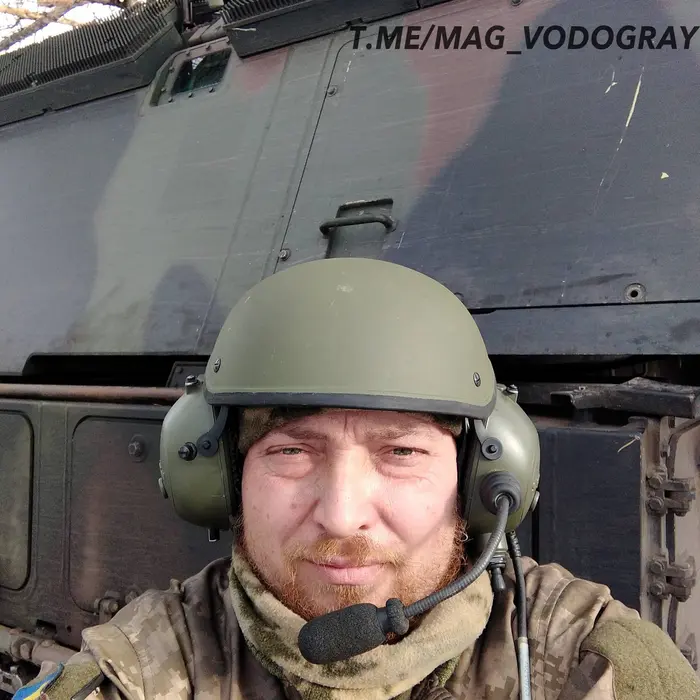 Is the information that the survivability of the barrels is much higher than stated is true?
Is the information that the survivability of the barrels is much higher than stated is true?
Who declared? Who, what? I know, we were told in Germany that the survivability of barrels is 25 thousand modules. If we shot on average at the 5th charge, the resource of the barrel is approximately 5 thousand shots.
Of course, we shot the 6th charge, and the 4th, and even the 3rd. But the 3rd was rare, so the basis: 4, 5 and 6. On average, the 5th turns out.
It is clear that the resource of 5000 shots is much more than on Soviet guns. The 2A65 Msta-B and the 2S19 Msta-S self-propelled gun have a barrel life of 3,000 shots at full charge. If you use a long-range charge, the resource of the barrel will generally drop to 2,000 shots.
Well, my self-propelled gun fired 6,500 shots during my tenure and after my injury. And after that, she was taken to replace the barrel. We took good care of the self-propelled guns, everything worked, but the resource of the barrel is the resource of the barrel.
But we still don't know how intensively they were exploited by 26 OABr and the Germans before that.
Such serious wear, of course, affected the accuracy of the self-propelled guns, but the guys still hit.
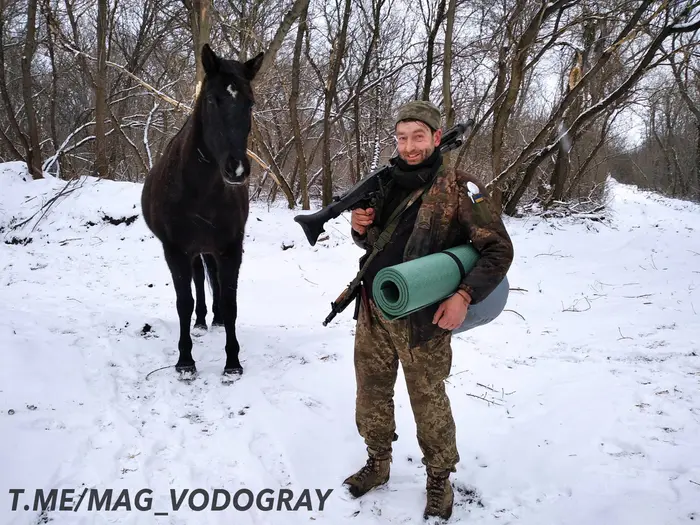 Are calculations protected from FPV drones? I have heard that there are portable "Candy" type analyzers that are used to detect UAVs. And are there any other complexes used, perhaps electronic devices?
Are calculations protected from FPV drones? I have heard that there are portable "Candy" type analyzers that are used to detect UAVs. And are there any other complexes used, perhaps electronic devices?
Well, at that time (even before the injury) FPVs had not yet reached us, only Lancets.
And in general, everything that exists to counter UAVs must be used. And camouflage, and UAV detection means and countermeasures.
Specifically, we didn't have Tsukoroku then.
But there was a certain REB, there was Nota, when we were still working on the Pion. Then it was noticeable that UAVs were flying, but they couldn't do anything to us.
Recently, they also took a spectrum analyzer and REEs for the boys.
Well, before we actually did not provide protection against UAVs ourselves. We agreed with those who were standing next to us, we once worked with Bukovel.
Another working scheme is to put 2-3 people on the rise near the firing position so that they "look" for enemy UAVs. The same Lancet is clearly visible, it has characteristic X-shaped wings that sparkle in the sun. And they just told you: "Lancet!". Bach, stopped, crawled into his shelter. The entrance to the "hole" was made diagonally so that the Lancet could not fly into the thicket after the self-propelled gun. After that, it flies into a branch at a speed of 160-170 km/h and breaks there.
Therefore, even observation is already very good.
Questions from the editors:
- Where did the 2S7 Pion maintenance team go to work when the crews retrained on the PzH-2000?
- Transferred to the infantry.
About BC for 2S7 Pion self-propelled guns, which are known to be still in use:
Currently, the 2S7 Pion calculations are firing American 203-mm shells, while using Soviet cartridge-type charges, because the Americans did not provide charges. But the devil is in the details - American shells are howitzers, not cannons. Soviet projectiles are designed for much higher pressure of powder gases. Accordingly, they are thin-walled, and when fired with a full charge, there is a high probability that the projectile will simply explode in the barrel of the gun. That is why American 203-mm shells are fired with reduced charges at short distances.
In the end - do you see a prospect for the PzH-2000 as the main self-propelled gun of the Armed Forces, or do the specifics of the database indicate that it is better to choose another installation?
Well, I'll tell you this: I didn't climb into the AS-90, I didn't climb into the M109 during the DB, but these are simpler machines. That's what I climbed into from cars of a similar class - it's in the AHS Krab. I saw it, and I want to tell you right away: it is an unfinished, ill-conceived and very crude car. The Poles "finished" it for 20 years and never completed it. It has a chaotically spread BC, thin armor. This is a failure.
There is nothing better than the PZH-2000, which is excellently protected, with significant upgrade potential, and AUTOMATIC PROJECTILE FEED. If you have straight hands, and you sufficiently maintain all the necessary mechanisms, then you touch the shells only when you load BC into the self-propelled gun. After that, you can shoot as you like, but you will not have to touch the projectile. And there is no such thing in Krab, there you have to pull everything with the handles, what can we say about simpler machines.
And if there is a desire to compare Krab and PzH-2000 in general, then go to Oryx and compare losses. The loss of 28 Crabs was verified, and there were 80 of them. We lost a third, a third! And if you look at the photo of the affected vehicles, then the detonation of self-propelled guns, together with the crew, is a very frequent phenomenon.
But there are 27 Panzerhaubitze, how many of them were destroyed? There are none. I know about the damaged ones, but their number can be counted on the fingers of one hand. And such that the BC detonated or one of the crew members died - never. Here is already a question of the literacy of the layout of the self-propelled guns.
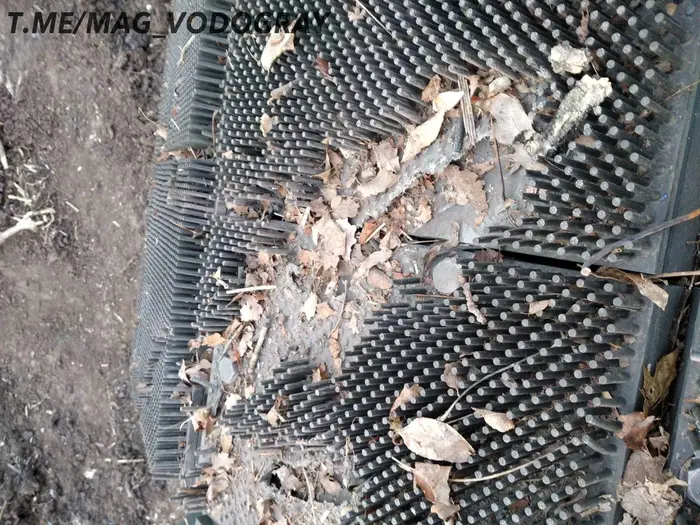 Another fragment of a 152-mm projectile passed through a protective element of the IGEL type (hedgehog).
Another fragment of a 152-mm projectile passed through a protective element of the IGEL type (hedgehog).
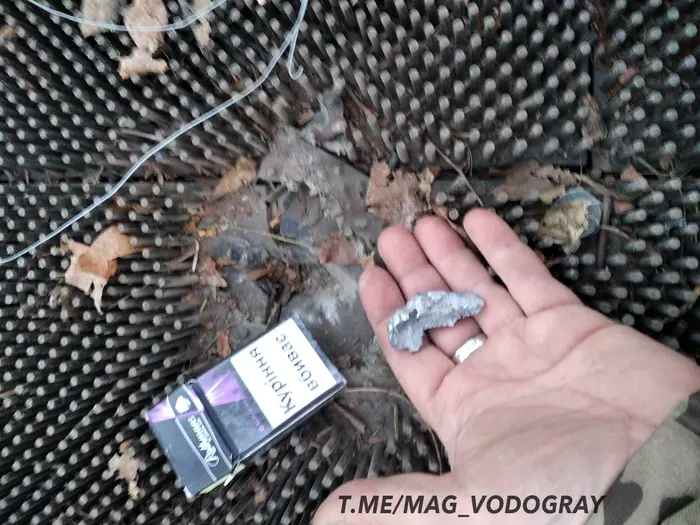
That's all. Initially, it was planned to make the interview much longer, but due to technical problems it is as it is now. There is still a small addition to this longread on the channel.
On behalf of the entire Vodogray SPJ team, I would like to thank Andriy Kobzar for the opportunity to talk and for the materials.
Thanks to everyone who helped in the preparation of the materials, special thanks to my friend Mykolka for asking a lot of questions. If you want to help us financially (for which we will be very grateful), here is a link to the bank.







